(Press-News.org) A new study by Dr. Zoë Lindo, a post-doctoral fellow in the Department of Biology at McGill University, and Jonathan Whiteley, a doctoral student in the same department, shows that large, ancient trees may be very important in helping forests grow.
These findings highlight the importance of maintaining the large old-growth trees in the coastal temperate rainforests that stretch from Southern Alaska to Northern California. Lindo's findings suggest that it is the interactions between old trees, mosses and cyanobacteria, which contribute to nutrient dynamics in a way that may actually sustain the long-term productivity of these forests.
"What we're doing is putting large old trees into a context where they're an integral part of what a forest is," says Dr. Lindo. "These large old trees are doing something: they're providing habitat for something that provides habitat for something else that's fertilizing the forest. It's like a domino effect; it's indirect but without the first step, without the trees, none of it could happen."
There are three players in this story: 1) large, old trees; 2) mosses that grow along their branches; and 3) a group of bacteria called cyanobacteria associated with the mosses. The cyanobacteria take nitrogen from the atmosphere and make it available to plants–a process called "nitrogen fixation" that very few organisms can do.
The growth and development of many forests is thought to be limited by the availability of nitrogen. Cyanobacteria in mosses on the ground were recently shown to supply nitrogen to the Boreal forest, but until now cyanobacteria have not been studied in coastal forests or in canopies (tree-tops). By collecting mosses on the forest floor and then at 15 and 30 metres up into the forest canopy, Lindo was able to show both that the cyanobacteria are more abundant in mosses high above the ground, and that they "fix" twice as much nitrogen as those associated with mosses on the forest floor.
Moss is the crucial element. The amount of nitrogen coming from the canopy depends on trees having mosses.
"You need trees that are large enough and old enough to start accumulating mosses before you can have the cyanobacteria that are associated with the mosses," Lindo said. "Many trees don't start to accumulate mosses until they're more than 100 years old. So it's really the density of very large old trees that are draped in moss that is important at a forest stand level. We surveyed trees that are estimated as being between 500 and 800 years old."
###
The research was funded by the Natural Sciences and Engineering Research Council of Canada (NSERC).
For an abstract of the article: http://www.springerlink.com/content/e651740234037w62/
Web page: http://biology.mcgill.ca/grad/zoe/index.html
Lab blog: http://www.ecodrift.blogspot.com/
Contact:
Katherine Gombay
Media Relations
McGill University
514-398-2189
katherine.gombay@mcgill.ca
Bacteria on old-growth trees may help forests grow
Biology researchers discover that bacteria living in mosses on tree branches
2011-06-08
ELSE PRESS RELEASES FROM THIS DATE:
Overweight more harmful to the liver than alcohol in middle-aged men
2011-06-08
Overweight carries a greatly increased risk of cirrhosis of the liver in men, reveals a new study from the Sahlgrenska Academy. "Given the increasing problem of overweight in Sweden, there is reason to fear that more people will develop cirrhosis of the liver," says Jerzy Kaczynski, docent at the Sahlgrenska Academy and doctor at Sahlgrenska University Hospital.
A group of researchers at the Sahlgrenska Academy has studied the link between overweight and the risk of developing cirrhosis of the liver in middle-aged men. Published in the Scandinavian Journal of Gastroenterology, ...
Using magnets to help prevent heart attacks
2011-06-08
If a person's blood becomes too thick it can damage blood vessels and increase the risk of heart attacks. But a Temple University physicist has discovered that he can thin the human blood by subjecting it to a magnetic field.
Rongjia Tao, professor and chair of physics at Temple University, has pioneered the use of electric or magnetic fields to decrease the viscosity of oil in engines and pipelines. Now, he is using the same magnetic fields to thin human blood in the circulation system.
Because red blood cells contain iron, Tao has been able to reduce a person's blood ...
Carbon release and global warming now and in the ancient past
2011-06-08
The present rate of greenhouse carbon dioxide emissions through fossil fuel burning is higher than that associated with an ancient episode of severe global warming, according to new research. The findings are published online this week by the journal Nature Geoscience.
Around 55.9 million years ago, the Earth experienced a period of intense global warming known as the Palaeocene–Eocene Thermal Maximum (PETM), which lasted for around 170,000 years. During its main phase, average annual temperatures rose by around 5°C.
Scientists believe that the warming may have been ...
Innovative device for quantum simulations
2011-06-08
A team of researchers from Columbia Engineering, the Italian National Research Council, Princeton University, University of Missouri, and University of Nijmegen (Netherlands) has developed an artificial semiconductor structure that has superimposed a pattern created by advanced fabrication methods that are precise at the nanometer scale. The pattern is similar to the honeycomb lattice that occurs in graphene. The device, called "artificial graphene" (AG), simulates quantum behavior of strongly interacting electrons. The research team sees the AG-device as a first step towards ...
Dolphins use double sonar
2011-06-08
Dolphins and porpoises use echolocation for hunting and orientation. By sending out high-frequency sound, known as ultrasound, dolphins can use the echoes to determine what type of object the sound beam has hit.
Researchers from Sweden and the US have now discovered that dolphins can generate two sound beam projections simultaneously.
"The beam projections have different frequencies and can be sent in different directions. The advantage is probably that the dolphin can locate the object more precisely", says Josefin Starkhammar, a newly examined doctor in Electrical ...
Will the eel survive its management?
2011-06-08
The European eel is on the way to disappearing for good. The species is critically endangered, and there are strong scientific arguments for suspending all fishing. Despite this situation, Swedish eel fishery is allowed to continue. Analysis of the eel management plan by the Swedish Institute for the Marine Environment identifies clear shortcomings. It is unlikely that Sweden will meet the target that has been set for silver eels capable of migrating back to the Sargasso Sea so that they can contribute to regeneration.
The recruitment of new annual cohorts of European ...
First of its kind study conducted by BUSM finds women as resilient to combat stress as men
2011-06-08
(Boston) - In what is believed to be the first published study on the topic, researchers affiliated with the Boston University School of Medicine (BUSM) believe female military service-members from Operation Enduring Freedom OEF)/Operation Iraqi Freedom (OIF) may be as resilient to combat-related stress as men. These findings currently appear on-line in the Journal of Abnormal Psychology.
Though the literature suggests that women may be more vulnerable to the effects of trauma exposure, most available studies on combat trauma have relied on samples in which women's combat ...
Red-light cameras critical to public safety, MU traffic researcher finds
2011-06-08
COLUMBIA, Mo. — As automated traffic monitoring systems such as red light cameras keep a law enforcement "eye" on the streets across the country, many drivers accuse city governments of installing the monitors as a way to generate revenue. New research from the University of Missouri says the safety benefits of automated traffic monitoring systems far outweigh the potential for abuse.
"A red light camera is not a panacea for traffic problems; it is a very effective tool for safe and efficient transportation," said Carlos Sun, an associate professor of civil engineering ...
Protein folding made easy
2011-06-08
Protein folding has nothing to do with laundry. It is, in fact, one of the central questions in biochemistry. Protein folding is the continual and universal process whereby the long, coiled strings of amino acids that make up proteins in all living things fold into more complex three-dimensional structures. By understanding how proteins fold, and what structures they are likely to assume in their final form, researchers are then able to move closer to predicting their function.
This is important because incorrectly folded proteins in humans result in such devastating ...
Paved surfaces can foster build-up of polluted air
2011-06-08
BOULDER—New research focusing on the Houston area suggests that widespread urban development alters wind patterns in a way that can make it easier for pollutants to build up during warm summer weather instead of being blown out to sea.
The international study, led by the National Center for Atmospheric Research (NCAR), could have implications for the air quality of fast-growing coastal cities in the United States and other midlatitude regions overseas. The reason: the proliferation of strip malls, subdivisions, and other paved areas may interfere with breezes needed to ...
LAST 30 PRESS RELEASES:
Numbers in our sights affect how we perceive space
SIMJ announces global collaborative book project in commemoration of its 75th anniversary
Air pollution exposure and birth weight
Obstructive sleep apnea risk and mental health conditions among older adults
How talking slows eye movements behind the wheel
The Ceramic Society of Japan’s Oxoate Ceramics Research Association launches new international book project
Heart-brain connection: international study reveals the role of the vagus nerve in keeping the heart young
Researchers identify Rb1 as a predictive biomarker for a new therapeutic strategy in some breast cancers
Survey reveals ethical gaps slowing AI adoption in pediatric surgery
Stimulant ADHD medications work differently than thought
AI overestimates how smart people are, according to HSE economists
HSE researchers create genome-wide map of quadruplexes
Scientists boost cell "powerhouses" to burn more calories
Automatic label checking: The missing step in making reliable medical AI
Low daily alcohol intake linked to 50% heightened mouth cancer risk in India
American Meteorological Society announces Rick Spinrad as 2026 President-Elect
Biomass-based carbon capture spotlighted in newly released global climate webinar recording
Illuminating invisible nano pollutants: advanced bioimaging tracks the full journey of emerging nanoscale contaminants in living systems
How does age affect recovery from spinal cord injury?
Novel AI tool offers prognosis for patients with head and neck cancer
Fathers’ microplastic exposure tied to their children’s metabolic problems
Research validates laboratory model for studying high-grade serous ovarian cancer
SIR 2026 delivers transformative breakthroughs in minimally invasive medicine to improve patient care
Stem Cell Reports most downloaded papers of 2025 highlight the breadth and impact of stem cell research
Oxford-led study estimates NHS spends around 3% of its primary and secondary care budget on the health impacts of heat and cold in England
A researcher’s long quest leads to a smart composite breakthrough
Urban wild bees act as “microbial sensors” of city health.
New study finds where you live affects recovery after a hip fracture
Forecasting the impact of fully automated vehicle adoption on US road traffic injuries
Alcohol-related hospitalizations from 2016 to 2022
[Press-News.org] Bacteria on old-growth trees may help forests growBiology researchers discover that bacteria living in mosses on tree branches



